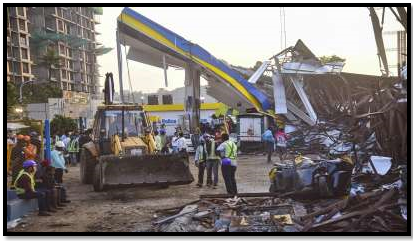“MUMBAI HOARDING COLLAPSE INCIDENT”
Syllabus:
- GS-3 : Urban infrastructure and related issues , Fulfillment of goal of sustainable urbanization
- GS-4 :Laws, rules, regulations, and conscience as sources of ethical guidance.
Focus :
- The focus area of the article is the collapse of a giant advertisement hoarding in Mumbai’s Ghatkopar area, highlighting the subsequent fatalities, regulatory lapses, legal responsibilities, and the need for stringent enforcement of safety norms.
- It underscores the broader implications for urban planning and disaster management amid increasing extreme weather events due to climate change.
Source - TH
Introduction
- A giant advertisement hoarding collapsed in Mumbai’s Ghatkopar area on May 13, resulting in at least 16 fatalities.
- The 250-tonne structure fell on a petrol pump below, where many victims were present either fueling up or working.
- Bhavesh Bhinde, the owner of the hoarding, absconded but was later arrested in Rajasthan.
Immediate Aftermath and Responsibility
- The collapse has led to pressure on the Municipal Corporation of Greater Mumbai (BMC) to inspect and take action against illegal or unstable hoardings.
- The Railways and Mumbai Port Trust are being urged to provide stability certificates for hoardings.
- Other cities, like Chennai and Pune, have also reacted by removing illegal hoardings and reassessing applications for new hoardings.
Safety Norms and Regulations
- Local bodies issue licenses for advertisement hoardings, requiring approval from an executive authority.
- The Mumbai Municipal Corporation Act (MMC) of 1888, specifically Section 328A, mandates written permission from the Municipal Commissioner for such structures.
- The 2018 Policy Guidelines for Display of Advertisements require structural stability certification from a registered engineer for hoardings.
- Despite these regulations, the collapsed Ghatkopar hoarding did not meet size norms and was not removed by officials.
- The Government Railway Police cited an ongoing dispute with the Corporation as the reason for not enforcing hoarding laws.
Technical Standards and Oversight
- The Bureau of Indian Standards (BIS) provides specifications for wind loads on hoardings under IS875, Part 3.
- The standards include formulas for calculating force coefficients for wind-facing structures.
- There is no public database of permits for hoardings, indicating a lack of transparency in enforcement.
- Legacy-style hoardings with inadequate foundations coexist with modern displays, particularly along highways and urban roads.
Impact of Extreme Weather
- The Mumbai hoarding collapse highlights the vulnerability of weak infrastructure to extreme weather events, such as cyclones and dust storms.
- Climate change is intensifying cyclones in the Arabian Sea, increasing the frequency and severity of such incidents.
- Roxy Mathew Koll from the Centre for Climate Change Research notes a 20%-40% increase in cyclone intensity in the Arabian Sea over the past four decades.
- Cities need to reassess the safety of large outdoor structures in light of increasing extreme weather events.
Legal Liability and Government Responsibility
- Governments and private structure owners have legal liability for accidents caused by unstable structures.
- The Delhi High Court ruled in 2022 that heavy winds are a foreseeable risk, rejecting the argument that such incidents are acts of God.
- Governments must show due diligence to prevent harm from official actions, ensuring the stability and integrity of public structures.
- The Ghatkopar case implicates several parties, including landowners, the agency responsible for the structure, and enforcement officials.
| Schemes for urban infrastructure development :
1.Smart Cities Mission
2. Atal Mission for Rejuvenation and Urban Transformation (AMRUT)
3. Pradhan Mantri Awas Yojana (Urban) (PMAY-U)
4. Heritage City Development and Augmentation Yojana (HRIDAY)
|
The Broader Implications
- The Ghatkopar disaster underscores the need for stronger enforcement of safety regulations for hoardings.
- It calls for greater accountability from municipal and disaster management authorities to prevent such tragedies.
- There is a need for comprehensive databases and transparent processes for issuing and monitoring hoarding permits.
- The incident serves as a wake-up call for urban planners to prioritize public safety in the face of climate change and extreme weather events.
Conclusion:
- The tragic collapse of the advertisement hoarding in Ghatkopar has exposed significant gaps in urban planning, enforcement of safety norms, and disaster management.
- It emphasizes the urgent need for municipalities to adopt stringent measures to ensure the structural stability of such installations, particularly in the face of escalating extreme weather events driven by climate change.
- The incident serves as a critical lesson for cities across India to prioritize public safety and robust infrastructure management.
Source:The Hindu
Associated article :
https://universalinstitutions.com/chapter-12-urbanization/
Mains Practice Question :
GS-3
“Discuss the implications of the Ghatkopar hoarding collapse incident in Mumbai on urban planning and disaster management. How can municipalities ensure the structural stability of hoardings in the context of increasing extreme weather events due to climate change?.” (250 words)




